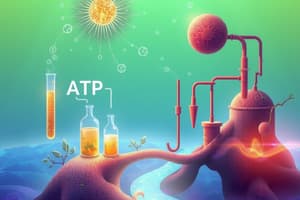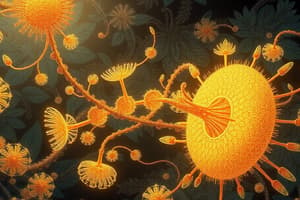Podcast
Questions and Answers
Which step of cellular respiration is responsible for making the most ATP molecules?
Which step of cellular respiration is responsible for making the most ATP molecules?
The electron transport chain
In fermentation, what molecule is converted to lactate (lactic acid)?
In fermentation, what molecule is converted to lactate (lactic acid)?
Pyruvate
What factor determines whether pyruvate is processed by cellular respiration or fermentation?
What factor determines whether pyruvate is processed by cellular respiration or fermentation?
Oxygen levels in the cells
Where in the cell does fermentation take place? (Select all that apply)
Where in the cell does fermentation take place? (Select all that apply)
Which step of fermentation is responsible for the majority of ATP production?
Which step of fermentation is responsible for the majority of ATP production?
Which of the following compounds is NOT produced during glycolysis?
Which of the following compounds is NOT produced during glycolysis?
Which of the following molecules carry electrons from the citric acid cycle to the electron transport chain? (Select all that apply)
Which of the following molecules carry electrons from the citric acid cycle to the electron transport chain? (Select all that apply)
In a molecule of sugar, where is energy stored?
In a molecule of sugar, where is energy stored?
Energy removed from sugar molecules is transferred to the electron transport chain by which of the following?
Energy removed from sugar molecules is transferred to the electron transport chain by which of the following?
Which stage of cellular respiration releases energy from electrons in slow, controlled steps?
Which stage of cellular respiration releases energy from electrons in slow, controlled steps?
Which molecule is oxidized during aerobic respiration?
Which molecule is oxidized during aerobic respiration?
During aerobic respiration, glucose is oxidized to form which molecule?
During aerobic respiration, glucose is oxidized to form which molecule?
During aerobic respiration, which molecule is reduced?
During aerobic respiration, which molecule is reduced?
Which stage of aerobic respiration includes oxaloacetate as a reactant?
Which stage of aerobic respiration includes oxaloacetate as a reactant?
Where in the cell does the electron transport chain that is part of the fourth stage of aerobic respiration take place?
Where in the cell does the electron transport chain that is part of the fourth stage of aerobic respiration take place?
Which stage of aerobic respiration produces the majority of the ATP yield?
Which stage of aerobic respiration produces the majority of the ATP yield?
In aerobic respiration, what is the final electron acceptor?
In aerobic respiration, what is the final electron acceptor?
Which of the following molecules are produced during glycolysis? (Select all that apply)
Which of the following molecules are produced during glycolysis? (Select all that apply)
Flashcards
Most ATP in cellular respiration
Most ATP in cellular respiration
The electron transport chain is the stage of cellular respiration that produces the most ATP.
Fermentation's pyruvate fate
Fermentation's pyruvate fate
Pyruvate is converted to lactate under low-oxygen conditions.
Cellular respiration vs. fermentation
Cellular respiration vs. fermentation
Oxygen availability determines whether pyruvate undergoes cellular respiration or fermentation.
Location of fermentation
Location of fermentation
Signup and view all the flashcards
ATP in fermentation
ATP in fermentation
Signup and view all the flashcards
Glycolysis missing product
Glycolysis missing product
Signup and view all the flashcards
Electron carriers to ETC
Electron carriers to ETC
Signup and view all the flashcards
Sugar's energy storage
Sugar's energy storage
Signup and view all the flashcards
Electron Transfer in respiration
Electron Transfer in respiration
Signup and view all the flashcards
Slow, controlled energy release
Slow, controlled energy release
Signup and view all the flashcards
Oxidized molecule in respiration
Oxidized molecule in respiration
Signup and view all the flashcards
Glucose oxidation product
Glucose oxidation product
Signup and view all the flashcards
Reduced molecule in respiration
Reduced molecule in respiration
Signup and view all the flashcards
Citric Acid Cycle Reactant
Citric Acid Cycle Reactant
Signup and view all the flashcards
Electron Transport Chain Location
Electron Transport Chain Location
Signup and view all the flashcards
Majority ATP in aerobic respiration
Majority ATP in aerobic respiration
Signup and view all the flashcards
Final electron acceptor
Final electron acceptor
Signup and view all the flashcards
Glycolysis products
Glycolysis products
Signup and view all the flashcards
Study Notes
Cellular Respiration Overview
- The electron transport chain (ETC) generates the highest ATP yield during cellular respiration.
- Oxygen levels dictate whether pyruvate undergoes cellular respiration or fermentation.
Fermentation Process
- Fermentation converts pyruvate into lactate (lactic acid).
- Anaerobic conditions direct pyruvate into fermentation pathways.
- Fermentation primarily occurs in the cytosol of the cell.
Glycolysis and ATP Production
- Glycolysis is responsible for most ATP generation within the fermentation pathway.
- Glucose is not a product of glycolysis; it is the substrate that gets broken down.
- During glycolysis, key molecules produced include NADH and ATP.
Role of Molecules in Cellular Respiration
- NADH and pyruvate are crucial in carrying electrons to the electron transport chain from the citric acid cycle.
- Energy in sugar molecules is stored within high-energy electrons in molecular bonds.
Electron Transport Chain
- Electrons carriers transfer energy removed from sugar molecules to the ETC.
- The ETC releases energy in a controlled manner during cellular respiration.
- The mitochondrial inner membrane hosts the electron transport chain.
Aerobic Respiration Details
- In aerobic respiration, glucose (C6H12O6) is oxidized, resulting in carbon dioxide (CO2).
- Oxygen (O2) is reduced during aerobic respiration, serving as the final electron acceptor.
- The citric acid cycle incorporates oxaloacetate as a reactant.
- Chemiosmosis, a stage of aerobic respiration, is responsible for most ATP production.
Studying That Suits You
Use AI to generate personalized quizzes and flashcards to suit your learning preferences.




